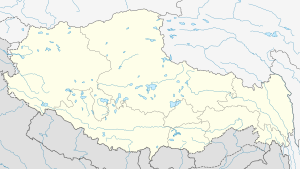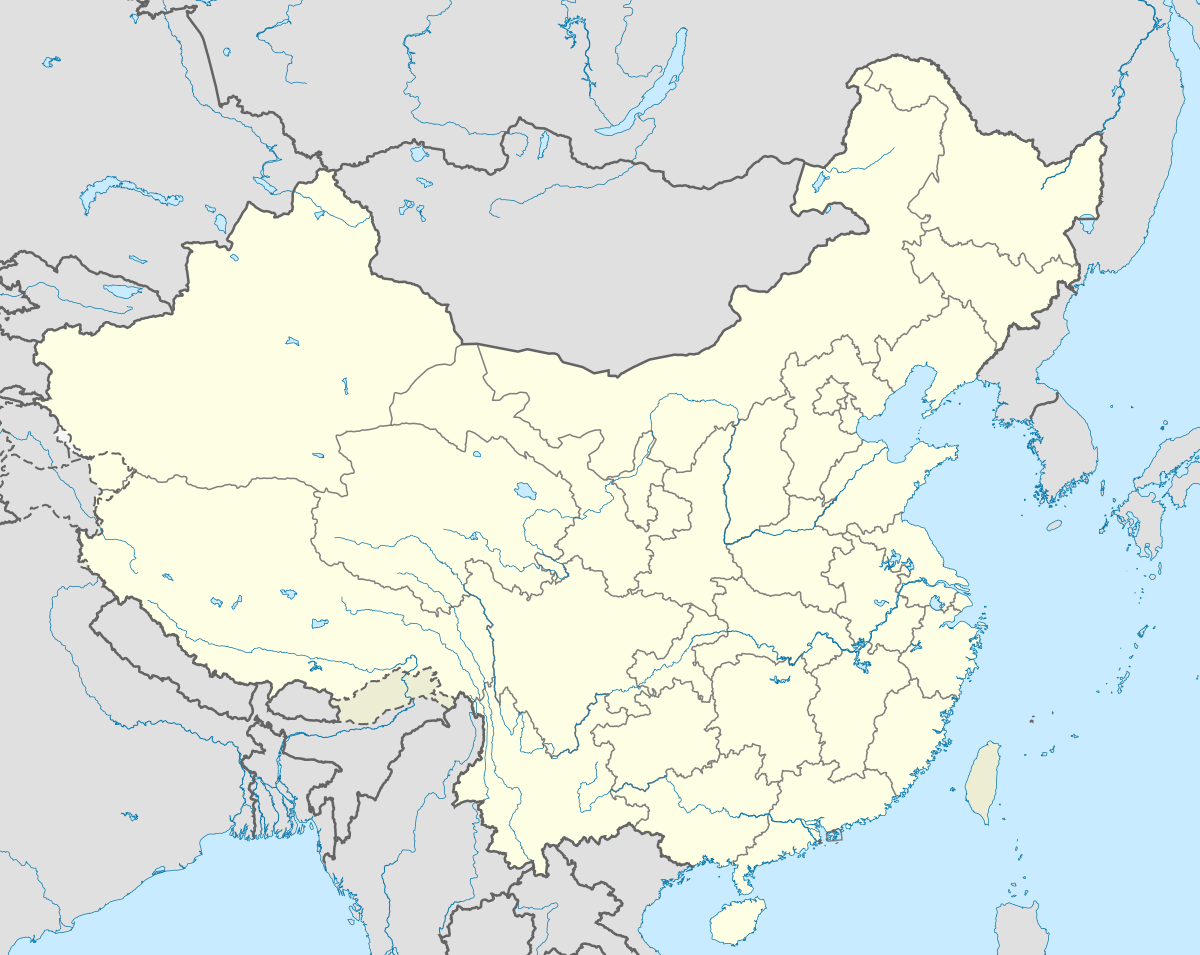Menri Monastery
Menri Monastery (Tibetan: སྨན་རི་, Wylie: sman ri — "medicine mountain") is the name of a Bon monastery in Tibet that has been refounded in India. The name derives from the medicinal plants and medicinal springs on the mountain.[1] Menri became the leading Bon monastery in the Tibetan cultural region. The abbot of Menri is recognized as the spiritual leader of Bon.
| Menri | |
|---|---|
| Religion | |
| Affiliation | Bon |
| Year consecrated | 1405 |
| Location | |
| Location | Namling County, Tibet Autonomous Region |
 Location within people's Republic of China  Menri Monastery (China) | |
| Geographic coordinates | 29.509°N 89.535°E |
| Architecture | |
| Founder | Nyamme Shérap Gyeltsen (Wylie: mnyam med shes rab rgyal mtshan , 1356–1416) |
| Menri Monastery | |||||
|---|---|---|---|---|---|
| Tibetan name | |||||
| Tibetan | སྨན་རི་ | ||||
| |||||
History
Menri Monastery was established in 1405 by Nyammé Shérap Gyeltsen (Wylie: mnyam med shes rab rgyal mtshan , 1356–1416) from Gyarong (Gyelrong), on the slope of Mount Shari Phowa (Wylie: shar ri pho ba ) in Topgyel (Wylie: thob rgyal ), Tsang.[2]
Nyammé Shérap Gyeltsen had been the eighteenth abbot of an old monastery also called Menri. The first monastery at Menri was founded in 1072 as Yéru Wensakha Monastery (Wylie: g.yas ru dben sa kha dgon pa ). It was destroyed by a flood in 1386.[1][3]
The new Menri Monastery, established in 1405, was founded in the Bru lineage of Bon and the Yéru Wensakha tradition.[4] "Many of the monks who succeeded [Nyammé Shérap Gyeltsen] were also from Gyarong."[5] The monastery practiced Yungdrung Bon, and was known "for its strict practice of monastic rules, which set a standard for other Bon monasteries."[3] Rinchen Gyeltsen was the second abbot.
The monastery had 32 abbots between its founding and 1966. The administration of the monastery is the subject of an article by Per Kvaerne.[6]
Sanggye Tendzin (1912-1978) served as lopön at Menri, and "was also in charge of printing important works of Dzogchen."[7]
Menri Monastery had four colleges: Lingmey (gLing-smad), Lingto (gLing-stod), Lingkey (gLing-ske) and Lingzur (gLing-zur). The colleges had twelve divisions and all together, in 1959, between 400 and 500 monks. Menri had 250 branch monasteries, in all areas of Tibet except U, as well as in India, China, Bhutan, Sikkim, Nepal, and Mongolia.[1]
In 1947, Menri itself established a debating college. Although Ensaka had the debate tradition study of sutra, tantra, and dzogchen, Menri was only able to institute it for sutra. The monastery carried out a full calendar of tantric rituals and practice.[1]
The administration of the monastery is the subject of an article by Per Kvaerne.[3]
Menri was destroyed during the Cultural Revolution.
Menri Monastery in India
In 1967, Menri was refounded at Dolanji in Himachal Pradesh, India by Lungtok Tenpai Nyima and Lopön Tenzin Namdak. This monastery has recreated the geshe training program, and is home to over two hundred monks. Menri in India and Triten Norbutse Monastery in Nepal now host the only two geshe programs in the Bon lineage.
See also
References
- Berzin, Alexander (1991). "A Brief History of Menri Monastery". Study Buddhism. Retrieved 2016-06-06.
- Achard, Jean-Luc (March 2010). "Nyamme Sherab Gyeltsen". The Treasury of Lives: Biographies of Himalayan Religious Masters. Retrieved 2013-10-08.
- Gray Tuttle; Kurtis R. Schaeffer (13 August 2013). The Tibetan History Reader. Columbia University Press. pp. 469–. ISBN 978-0-231-51354-8.
- Andrew N. Woznicki (2006). Transcendent Mystery in Man: A Global Approach to Ecumenism. Academica Press,LLC. pp. 60–. ISBN 978-1-933146-15-7.
- Gray Tuttle; Kurtis R. Schaeffer (13 August 2013). The Tibetan History Reader. Columbia University Press. pp. 483–. ISBN 978-0-231-51354-8.
- Gray Tuttle; Kurtis R. Schaeffer (13 August 2013). The Tibetan History Reader. Columbia University Press. pp. 472–. ISBN 978-0-231-51354-8.
- Achard, Jean-Luc (March 2010). "Sanggye Tendzin". The Treasury of Lives: Biographies of Himalayan Religious Masters. Retrieved 2013-10-08.
External links
- Berzin, Alexander (1991). "A Brief History of Menri Monastery". Study Buddhism. Retrieved 2016-06-06. Alexander Berzin, 1991, expanded September 2003. Original version published in "Bön Monasteries." Chö-Yang, Year of Tibet Edition (Dharamsala, India), (1991)
- The Bon Foundation
- Menri Monastery Protected Area Permit
- Menri, Tibetan Monastery Inventory
- Menri Monastery Photos and Video, Bill Megalos